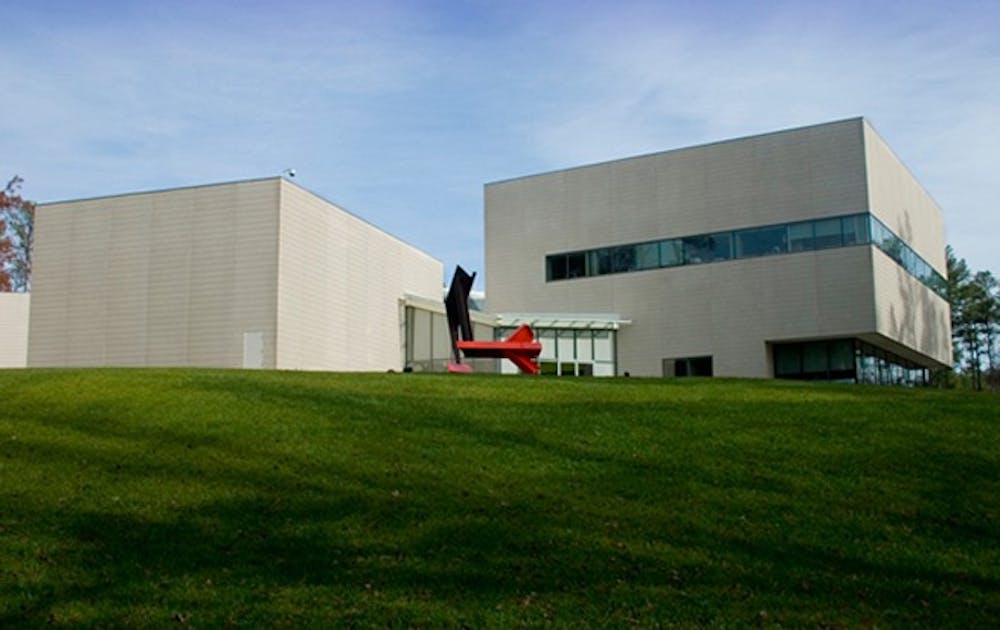For the media-soaked American viewer, the incisive humor behind Alexander Kosolapov’s 1988 screenprint Lenin-Coca-Cola is its ambiguity of target. Part of the Nasher’s new Education Corridor exhibition, The Subverted Icon: Images of Power in Soviet Art (1970-1995), Kosolapov’s work sweeps satire across two nations and cultures. The Marxist revolutionary and the icon of capitalism face each other, both stenciled in the Coke/communist-red-on-white decor of classic ‘50s billboards, to create a bizarre contrast. An uncharacteristically informal quote by Lenin promoting the soft drink—“It’s the Real Thing”—gives the fake-ad the explicitly dissident comedy the artist intended.
The politically charged farce is part of a sixteen-piece installation organized by students of Professor Pamela Kachurin’s “Soviet Art After Stalin” seminar. Using works previously collected in Nasher storage, the students assembled their own series, noted Kachurin, and were responsible for selecting individual works, writing label texts and arranging them to create thematic unity.
Senior Julia Rayis, a student who contributed to the exhibition, describes the criterion for curation: “We chose representations of power because we felt that every person would get to work with a piece that they were really interested in, and all of the pieces tie into that one way or another,” explained Rayis.
The class’s efforts to unify a group of works was not in vain; the installation has an immediate sense of tonal harmony. The collection of etchings, sculptures and prints all typify the non-conformist period of Soviet art. Their importance, of course, is best understood in historical context: having been granted new expressive freedoms under Krushchev leniency and Gorbachev’s glasnost (“openness”) policies, the late 20th century Slavic intelligentsia was eager to break the Socialist Realist mold. Each work communicates its criticisms of the party regime uniquely, but all approached the icons of the Soviet state with suspicion. The installation description summarizes their sociopolitical effects, that through displacement of symbols of power, the “three major institutions of Soviet culture—communism, architecture, and the media—[were] confronted and challenged.”
A representative work captures the essence of the exhibition: Oleg Vassilev’s Leaders, a tweaked issue of the communist bulletin Pravda, exemplifies Soviet artists’ pent-up criticisms of the regime. Vassilev’s lithograph overlays black silhouettes of KGB officers across a Pravda front-page. An isolated, small, white figure sprints away from the viewer into the depths of a large dark mass. An unidentified set of legs approaches the viewer menacingly, surrounded by a wash of red that connotes “blood” as much as it does “The Party.” Such a deliberately sinister portrayal of Stalinist communism was only feasible under glasnost; thus, Vassilev’s 1992 work arrives in the wake of growing artistic boldness.
I say “growing,” because freedom of artistic expression was only nascent in the 1970s, and for Russian artists it is still maturing. Vitaly Komar and Alexander Melamid’s work Onward to the Final Victory of Capitalism—an ironic fusion of socialist propaganda with James Bond as an American-flag-waver—is also featured. The collaborators made history when they took part in the notorious 1974 “Bulldozer Exhibition.” The unofficial, underground installation in Moscow was disbanded by the secret police force, who used bulldozers to destroy all the works and water cannons to attack the artists and spectators.
On its own, memory of the incident demonstrates the historical gravity behind the works in The Subverted Icon, but recent reminders of the country’s artistic restrictiveness add to the exhibition’s relevance. In 2010, curators for the “Forbidden Art” exhibition in Moscow’s Sakharov Museum were jailed for unveiling Kosolapov’s new work This is My Blood/Body (the piece rendered Coca Cola and McDonald’s as substitutes for the Eucharist). Just last week, members of the punk-rock group Pussy Riot were sentenced to two years in a labor camp for “hooliganism motivated by religious hatred” after their non-violent protest concert in a cathedral.
Yet what makes The Subverted Icon especially exciting, in a youthful, rebellious way, is that it’s not just Soviet idols being overthrown. The United States and consumerism are as much the butt of Komar, Vassilev, and Kosolapov’s jokes as are Lenin and Soviet architecture. Upon viewing Leonid Sokov’s Untitled (Bear and Marilyn Monroe), which shows the gleeful, swimsuited pop icon being chased by a lustful Russian Bear, I found it hard to stifle laughter at the unusual juxtaposition. When I described my reaction to the work (I thought the scene was “funny”) Kachurin retorted, “It is, until you realize that bear is Stalin.”
The Subverted Icon: Images of Power in Soviet Art (1970-1995) will be on display at The Nasher Museum of Art until December 23rd.
Get The Chronicle straight to your inbox
Signup for our weekly newsletter. Cancel at any time.

